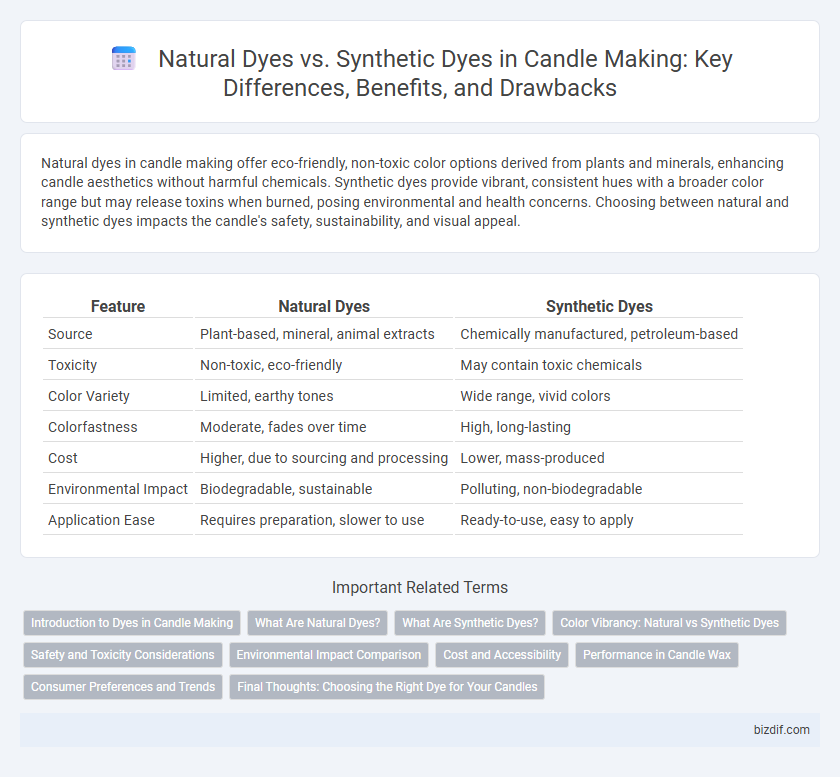Natural dyes in candle making offer eco-friendly, non-toxic color options derived from plants and minerals, enhancing candle aesthetics without harmful chemicals. Synthetic dyes provide vibrant, consistent hues with a broader color range but may release toxins when burned, posing environmental and health concerns. Choosing between natural and synthetic dyes impacts the candle's safety, sustainability, and visual appeal.
Table of Comparison
| Feature | Natural Dyes | Synthetic Dyes |
|---|---|---|
| Source | Plant-based, mineral, animal extracts | Chemically manufactured, petroleum-based |
| Toxicity | Non-toxic, eco-friendly | May contain toxic chemicals |
| Color Variety | Limited, earthy tones | Wide range, vivid colors |
| Colorfastness | Moderate, fades over time | High, long-lasting |
| Cost | Higher, due to sourcing and processing | Lower, mass-produced |
| Environmental Impact | Biodegradable, sustainable | Polluting, non-biodegradable |
| Application Ease | Requires preparation, slower to use | Ready-to-use, easy to apply |
Introduction to Dyes in Candle Making
Natural dyes in candle making are derived from plant-based materials such as turmeric, beetroot, and annatto, offering eco-friendly and non-toxic color options that enhance the candle's aesthetic with subtle, earthy tones. Synthetic dyes, composed of petroleum-based chemicals, provide a wide spectrum of vibrant, consistent colors with higher colorfastness and ease of use in various wax types like soy, paraffin, and beeswax. Understanding the difference between natural and synthetic dyes helps candle makers select appropriate coloring agents that affect the candle's appearance, burn quality, and environmental impact.
What Are Natural Dyes?
Natural dyes are colorants derived from plant materials, minerals, and insects, providing eco-friendly and non-toxic alternatives for candle making. These dyes offer rich, earthy hues that vary depending on the source, such as roots, leaves, flowers, and bark. Using natural dyes enhances the sustainability of candles by avoiding synthetic chemicals and promoting biodegradable ingredients.
What Are Synthetic Dyes?
Synthetic dyes are man-made colorants produced from chemical compounds, commonly used in candle making for their vibrant and consistent hues. Unlike natural dyes derived from plants or minerals, synthetic dyes offer a broader color spectrum and greater stability during the candle's burning process. These dyes are often preferred for their ability to maintain intense coloration without fading, enhancing the aesthetic appeal of candles.
Color Vibrancy: Natural vs Synthetic Dyes
Synthetic dyes in candle making produce more vibrant and consistent colors compared to natural dyes, which often yield softer, muted tones due to their plant-based origins. Natural dyes tend to fade faster when exposed to light and heat, while synthetic dyes maintain their intensity and brightness over time. Candle makers seeking bold, long-lasting hues typically prefer synthetic dyes for color vibrancy and reliability.
Safety and Toxicity Considerations
Natural dyes used in candle making are generally safer due to their non-toxic, biodegradable properties, reducing the risk of harmful fumes during burning. Synthetic dyes, while offering vibrant and consistent colors, may release toxic chemicals like heavy metals and carcinogens when heated, posing health hazards. Careful selection and testing of dyes are crucial for ensuring candle safety and minimizing exposure to potentially harmful substances.
Environmental Impact Comparison
Natural dyes, derived from plants and minerals, have a lower environmental footprint due to their biodegradability and minimal chemical processing, reducing soil and water pollution during candle production. Synthetic dyes, often petroleum-based, contribute to environmental degradation by releasing harmful chemicals and microplastics, which persist in ecosystems and complicate waste management. Choosing natural dyes supports sustainable practices by minimizing ecological harm and promoting eco-friendly candle crafting.
Cost and Accessibility
Natural dyes for candle making often come from plants, spices, and minerals, making them eco-friendly but typically more expensive and less readily available in large quantities. Synthetic dyes, derived from petrochemicals, offer a cost-effective and widely accessible option, providing vibrant and consistent colors suitable for mass production. Candle makers must balance budget constraints with sustainability preferences when choosing between these dye types.
Performance in Candle Wax
Natural dyes offer subtle, earthy tones and are biodegradable, but often fade quickly and lack color consistency in candle wax. Synthetic dyes provide a broader color spectrum, vibrant hues, and excellent heat stability, resulting in longer-lasting, uniform coloration in candles. Performance-wise, synthetic dyes outperform natural dyes in maintaining color intensity and stability during the candle burning process.
Consumer Preferences and Trends
Consumer preferences in candle making increasingly favor natural dyes due to their eco-friendly properties and non-toxic nature, aligning with growing environmental awareness. Natural dyes, derived from plant-based sources, offer subtle, unique hues that appeal to wellness-focused buyers, while synthetic dyes provide more vibrant, consistent colors but raise concerns about chemical exposure. Trends indicate a rising demand for sustainable and health-conscious products, driving artisans to blend both dye types to balance aesthetics with safety and market appeal.
Final Thoughts: Choosing the Right Dye for Your Candles
Natural dyes offer eco-friendly, non-toxic options that provide subtle, organic hues ideal for artisanal candle making, while synthetic dyes deliver a broader color spectrum with consistent, vibrant results and longer-lasting color stability. Considering factors such as environmental impact, color intensity, and candle type helps determine the best dye choice for your specific candle-making project. Balancing aesthetics with sustainability preferences ensures the final product meets both creative and ethical standards.
Natural dyes vs Synthetic dyes Infographic

 bizdif.com
bizdif.com